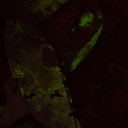It rains a lot in the Luquillo mountains – more than three meters each year. The earth’s gobal circulation means that clouds blow in from the east, are pushed again the mountains, rise up, cool down, and then lose the capacity to hold water vapor – causing precipitation.
What that means is that a lot of nights are spent on the porch, watching the rain come down.
Sometimes the rain leads to soil erosion or wind, and this causes treefalls. Treefalls, in turn, lead to power outages. And power outages lead to even quieter nights illuminated only by oil lamps. When there are no motors, no vibrations, and nothing mechanical to disturb the calm, the forest becomes very peaceful.
This moisture leads to very high rates of decomposition out in the forest. Large treees that fall in one year can be impossible to find the next year. We found this out the hard way on many occasions. Decomposition is aided by a high density of fungi in the forest. Most of these extend through countless mycelia, thin filaments growing into dead plant tissues, slowly breaking down resources. On a quiet rainy night, it is well worth going to look for these fungi.
The reason is that some of these fungi have an extraordinary secret. On a moonless night, one may walk deep into the forest, and wait ten or fifteen minutes in the darkness. Slowly the pure black will become different shades of deep blue-grey, and the vague forms of trees and rocks may begin to appear. And the forest floor will begin to glow a tentative shade of green.
Most forests don’t glow in the dark, but this one does. Dacryodes excelsa leaves and stems seem to be preferentially decomposed by a mycelial fungus that emits a pale green shade of light. It is hard to imagine walking through this landscape. Reality bends, just a little.
With a long exposure, it’s possible to see far more detail than with the naked eye. Above you can see the fungus is growing primarily at the edges of the leaf, breaking it down where the most surface area is available. I don’t know why the species glows, but it makes for a beautiful sight on a silent evening hike. We’ve thought idly about using them for lighting the field station during power outages, but the glow is weak and stops as soon as the leaves dry out. Better, then, to enjoy it where it lives naturally!






Comments
One response to “Glows in the dark”
Fascinating. Thanks for the wonderful natural history and the photos. Wish I could have seen the glowing forest on this trip.